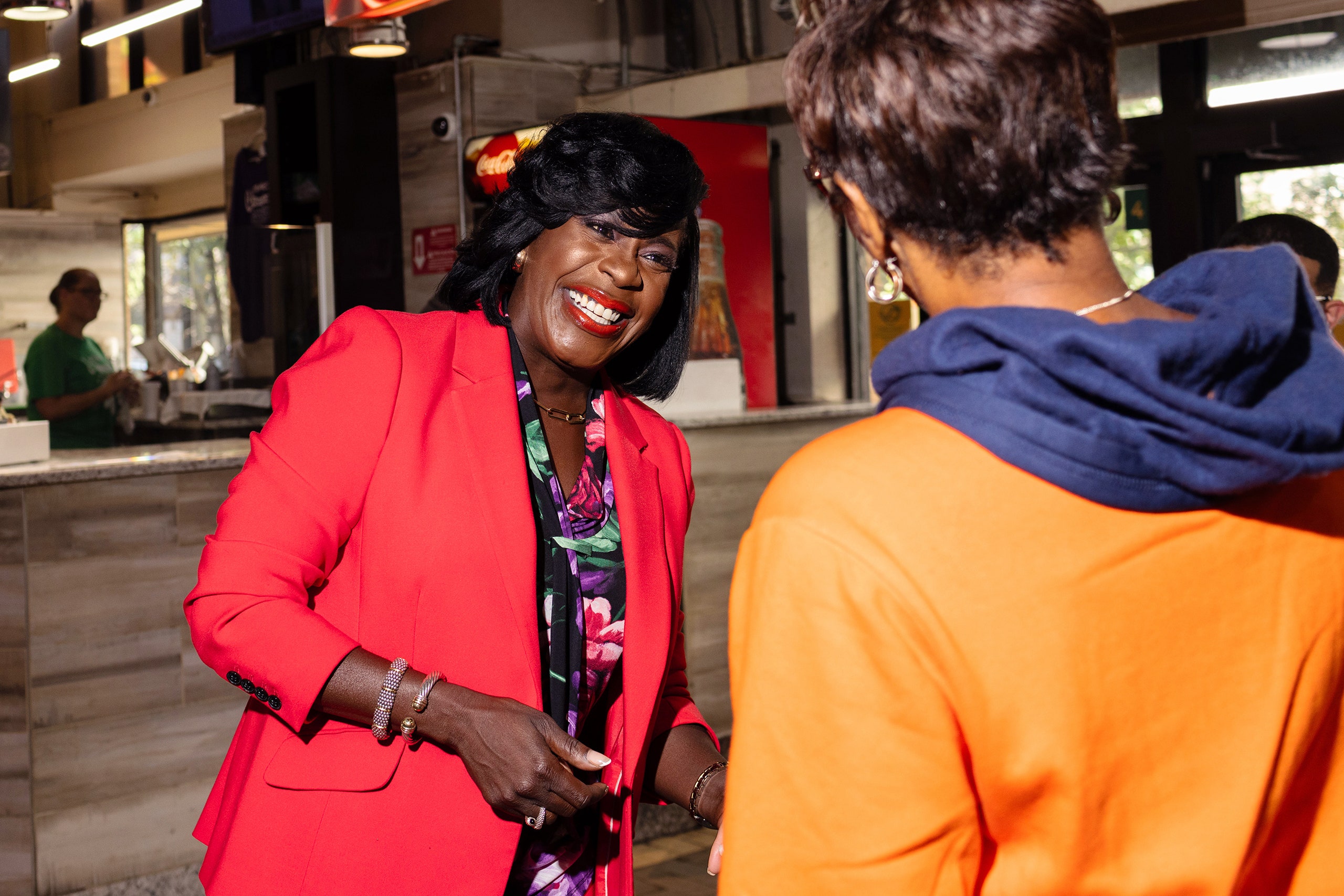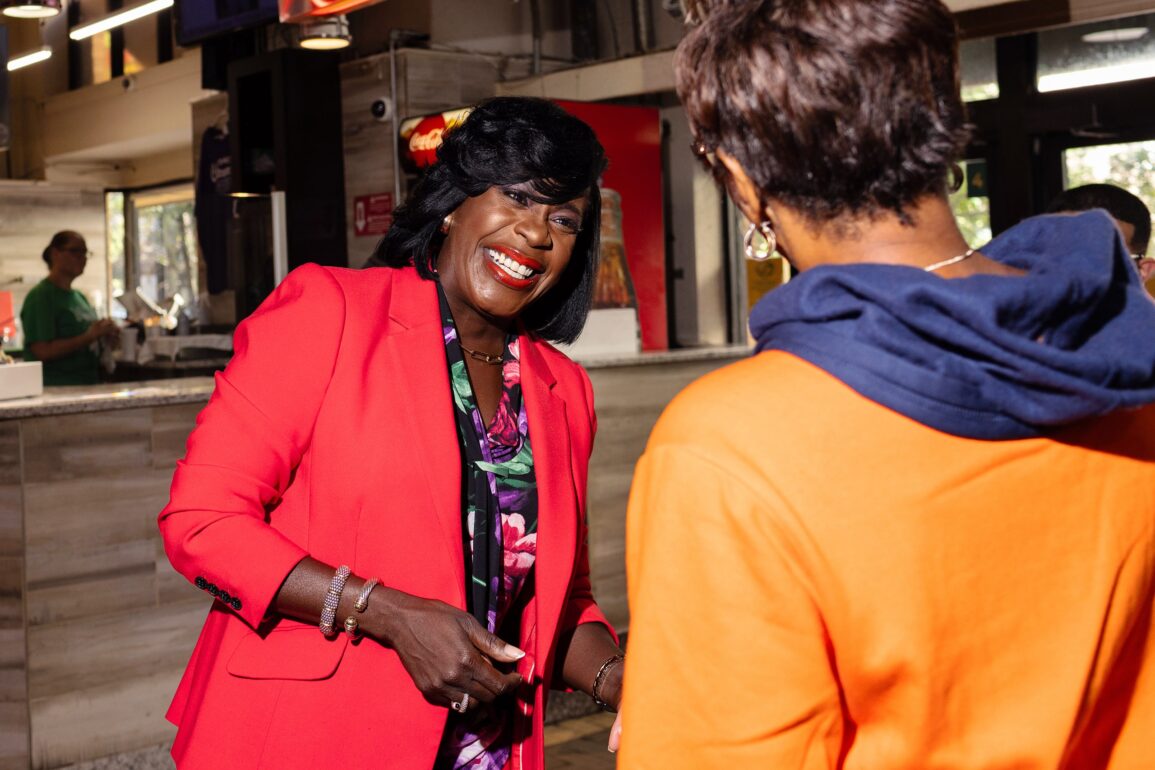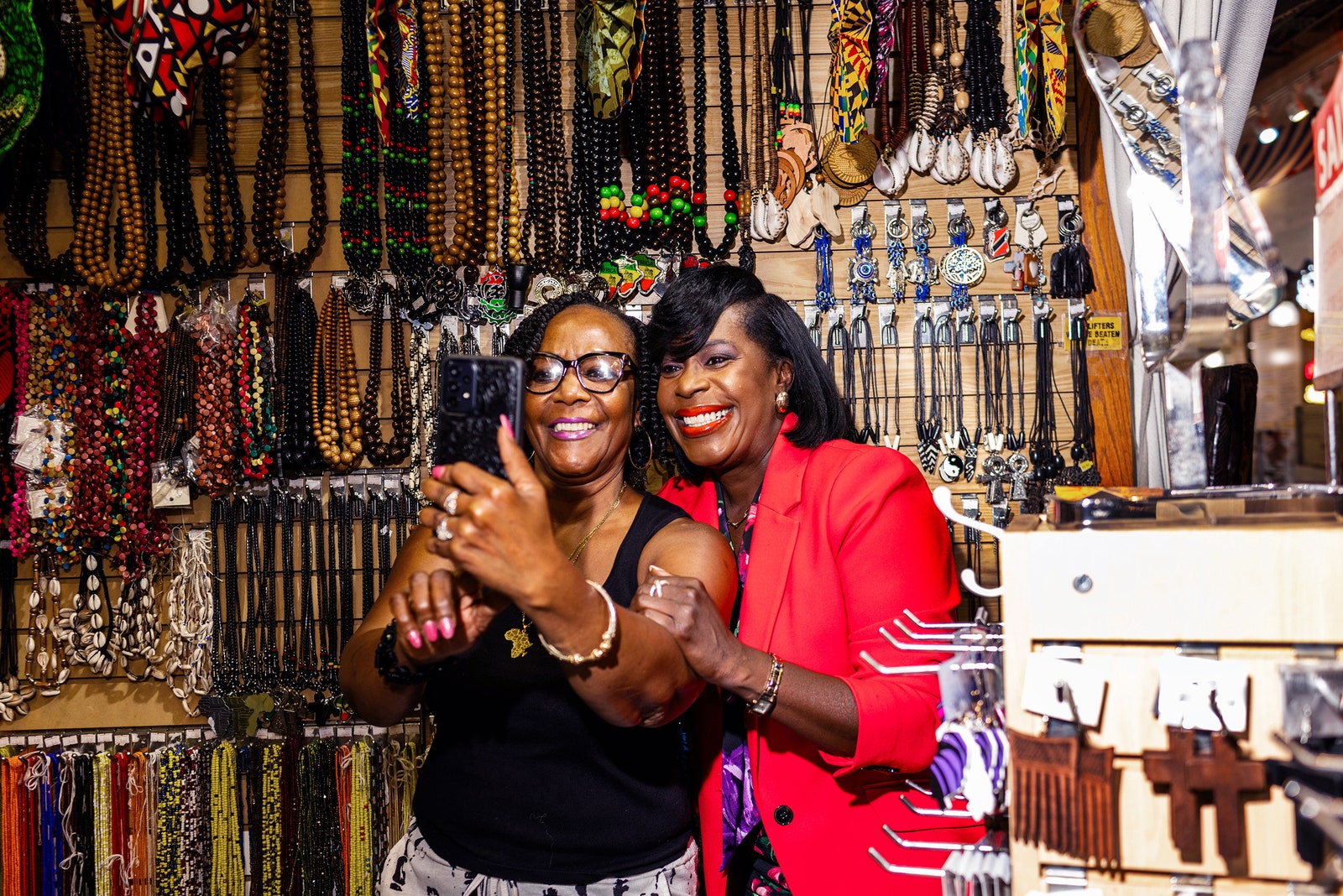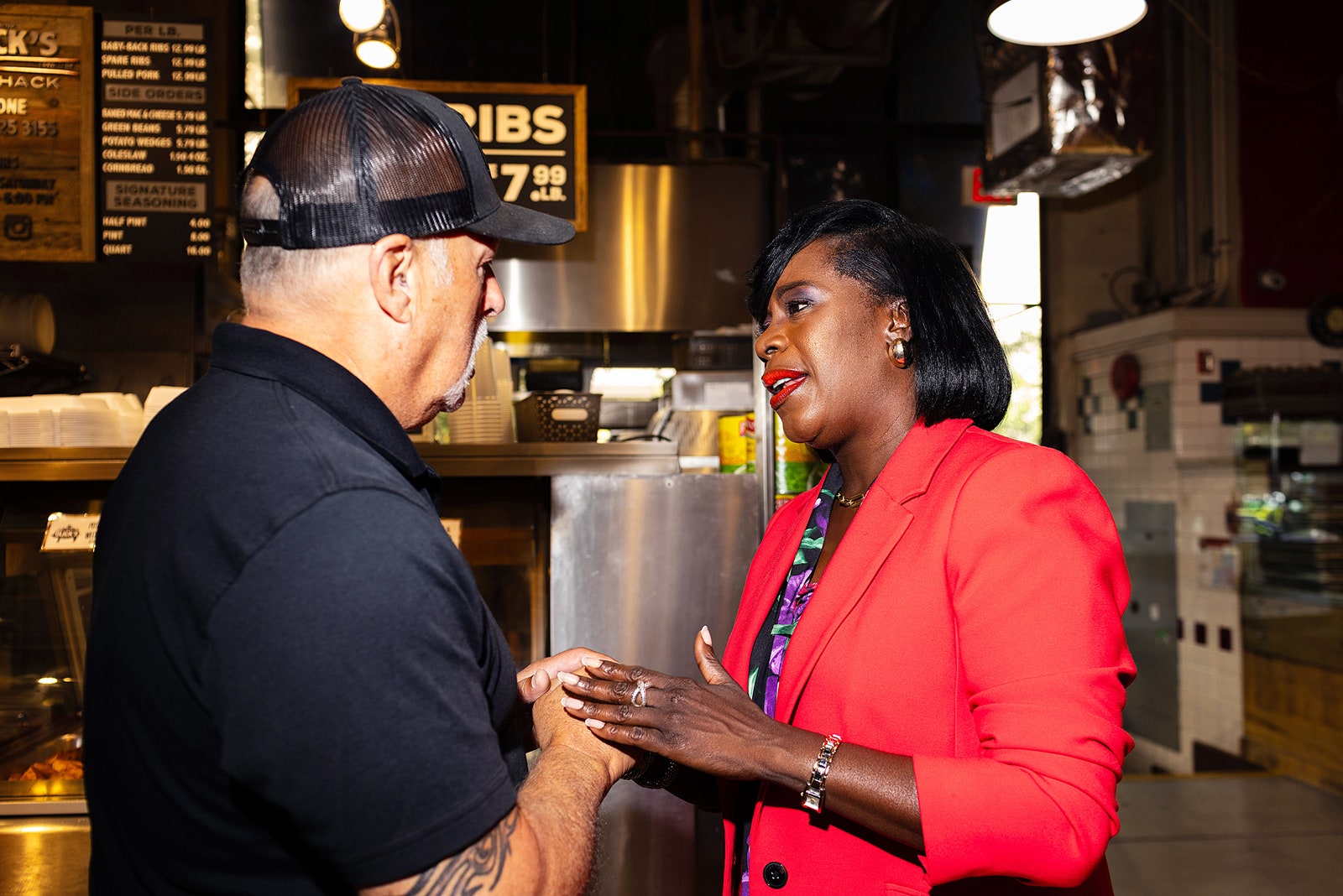
Cherelle Parker Defies the Progressive Agenda
Philadelphia’s new mayor insists that the city’s safety depends on expanding its police department.
On Tuesday, Cherelle Parker took the stage at the Sheet Metal Workers hall to announce her election as Philadelphia’s hundredth mayor. Parker, who is fifty-one, was wearing a red-lace power suit. “God is good!” she called to the audience. “All the time!” The crowd erupted into whoops and cheers. “A lot of campaign experts thought they would tell us the way we should walk, talk, and act to win an election and get votes,” Parker, who was flanked by her eleven-year-old son, Langston, and her political mentor, the former city councilwoman Marian Tasco, began. “It just didn’t feel right.”
On November 7th, Parker easily defeated the Republican candidate, a former city councilman David Oh, with seventy-five per cent of the vote. The real race was in last spring’s primary, where, at first, her prospects looked dim against better-known and better-funded candidates—including Rebecca Rhynhart, the city controller, who campaigned to the left of Parker, and Helen Gym, a community organizer and progressive darling, who received endorsements from Bernie Sanders and Alexandria Ocasio-Cortez.
“I’m not one of those people,” Parker told me. “I’m not a defund-er. I’m not a left-er. I think a whole lot of it is a bunch of bullshit.” Instead, she ran as an outspoken centrist, promising to make Philadelphia “safe, clean, and green.” During the first mayoral debate, she stated her opposition to defunding the police. She was the only Democratic candidate to support stop-and-frisk policing, which, according to data analyzed by the Pennsylvania A.C.L.U., disproportionately affects Black Philadelphians. She also proposed that the city hire three hundred more police officers, a plan that Philadelphia magazine has called “regressive” and “wasteful.”
This past summer, I met Parker outside the Kelly-green row house where her great-grandmother lived when she was young, in Strawberry Mansion. “You can’t understand my passion for certain policy initiatives without knowing that this is where I come from,” she told me. During the seventies, Strawberry Mansion was a leading Black working-class neighborhood, and residents color-coördinated pots of geraniums and impatiens. “Nobody here was rich. But there was enough for everybody and a desire to take care of what you have,” Parker said. But, as Philadelphia became the poorest large city in the country, the neighborhood fell into disrepair. The sidewalk was buckling, and green paint flaked off the home’s front steps, which she had scrubbed as a child. “On the campaign trail, when I talked about scrubbing the steps, younger people looked at me, like, ‘What’s she on?’ ” Parker laughed.
On the stoop, five of Parker’s family members—two aunts and three cousins, all women—sat listening. From time to time, they broke in to rib Parker, who was eight when her cousins first predicted that she’d become mayor. “She talked, talked, talked, talked, talked,” Marlene Trice, Parker’s maternal aunt, said. “Oh, baby, she could talk!” Trice, who wore a Care Bears T-shirt that read “Careful, I’m Grumpy,” is the founder and C.E.O. of Kitchen of Love, a food pantry she started running out of Parker’s basement in 2005. Many of the households that Kitchen of Love serves are headed by seniors, who show up three times a week at 4:30 A.M. for a thirty-pound box of peanut butter, tuna fish, and vegetables, along with a two-pound block of cheese.“I don’t ask for identification. No nothing. If you stand in line, you need it,” Trice said. She glanced around at the state of their old neighborhood. “Look at the trash,” she tut-tutted. “We could sit outside all night, leave the door open, and go to the store,” she explained. “Now you can’t even come to your door.”
Parker had brought me to Strawberry Mansion to make a larger point. “I grew up learning that politics is simply a tool that is used to decide how scarce resources are allocated,” she told me. “If I don’t see my tax dollars at work in the community that I live in, what about this process is working?” She offered the trash-strewn block a disapproving look. “I see glass, I see trash. I don’t see thriving businesses. I don’t want my child to play in the park because there are needles in the park. I don’t want him to play basketball there.”
A stranger walked past, calling to Parker, “I went out on the pavement for you!” Dressed in black and on her way to a catering job, she introduced herself as Tosha Taylor, a community organizer who had knocked on doors for Parker during the primary campaign. “It wasn’t just the fact that she wants to make a change,” Taylor said. “It was the fact that I felt it.” Taylor is a mother of ten. “I raised all ten,” she told Parker. “I taught them how to clean, I taught them how to cook. And I taught them how to be model people in society.” She’d found her way out of homelessness and living in shelters through cooking school. Now Taylor had come to believe that trade school could interrupt intergenerational poverty.
As Taylor walked away, Parker told me, “You’ve got families out here barely making it, having to choose between paying their electric, feeding their children, or making sure they have somewhere to live. That’s an amazing injustice.” She went on, “If you are an elected official, every policy that you advocate for has to directly impact the lives of the people in the community. And it should be tangible. They should be able to see it, touch it, taste it, feel it.” She gave the block another look and said, “Black Lives Matter—but every time I walk out of my house, it’s dirty?”
Nearly half of Philadelphia’s 1.5 million residents are Black, and they are aware of their tremendous political power. “Black people saw on TV and on their phones that their votes mattered in 2020,” Donna Bullock, a state representative, told me. “Which is why so many folks were trying to stop those votes from being counted by crossing state lines and putting guns in their cars.” Philadelphia’s Black electorate could, by coming out to the polls, determine the outcome of the 2024 Presidential election—and, to the surprise of many, Parker’s messaging about public safety resonated with those voters. “Cherelle was one of the first people to say that Black people do want law enforcement involved in making our city safer,” Sharif Street, a member of the state senate, told me. “We just want them to do their job properly.”
Parker’s critics argue that her ideas are dangerous and anachronistic. Many of her proposals, such as installing surveillance cameras and impounding illegal vehicles, fall under the theory of “broken windows,” which dates to the nineteen-eighties and links a degraded physical environment to higher rates of crime. There is little credible evidence to support the theory, and yet its popularity persists. “If she pursues ‘broken windows,’ these horrible backwards policies will fail,” Robert Saleem Holbrook, the executive director of the Abolitionist Law Center and lecturer at the University of Pennsylvania’s law school, told me. “The minute they do, we will drag her administration into court, and it will cost the city tens of millions of dollars.”
Last month, Parker casually remarked that, as mayor, she would bring in the National Guard to patrol the streets of Kensington, the center of the city’s opioid epidemic. “Cherelle Parker has this idea she’s going to bring the National Guard to chase drug addicts up and down Kensington Avenue, but they’re not trained to do that,” Holbrook said. “Any slipup on their part reflects on her.” (Parker later walked this comment back.)
Philadelphia is one of the most segregated cities in America, with white residents remaining in traditionally Irish and Italian American enclaves, Black residents isolated in the poorest neighborhoods, and a centuries-old history of racialized law enforcement. But attitudes toward policing don’t break down along racial lines, in Philadelphia or elsewhere. “There is a white-liberal fallacy that people of color are against the police,” Michael Nutter, who served as Philadelphia’s mayor from 2008 to 2016, told me. “That’s not true. They’re against police brutality.”
Nutter was a vocal proponent of stop-and-frisk, as part of a larger program of crime deterrence. As he put it, “Leave your gun at home, or you’re going to jail.” But stop-and-frisk has a dismal history in the city. “When you look deep into the data, you find that ninety per cent of people stopped during stop-and-frisk are innocent,” David Rudovsky, a civil-rights attorney who has been practicing in Philadelphia for the past fifty years, told me. In 2010, Rudovsky sued the city for its unconstitutional use of stop-and-frisk, and, for the past decade, Philadelphia has been under court order to monitor the practice.
Philadelphians remain divided in their opinions about the police. In 2017, they elected Larry Krasner as district attorney on a platform of ending impunity for law-enforcement officials. Krasner has since charged four officers with murder, winning the first recorded conviction against an on-duty Philadelphia police officer. His anti-mass-incarceration platform, including ending cash bail and decriminalizing low-level offenses, earned him Black supporters—and made him a polarizing figure in Pennsylvania politics. He was the subject of an impeachment campaign by Republican state legislators, and he’s frequently accused by law enforcement of being “anti-police.”
Parker has announced a zero-tolerance policy on misconduct by law enforcement, but she staunchly believes that policing plays a role in tackling gun violence. Her plan for proactive policing involves sending three hundred new officers out into ten neighborhoods, on walking or bike-riding beats. To defend her vision, she invokes the idyllic Philadelphia of an earlier era—where, she recalls, beat cops on foot were “guardians, not warriors.” (A spokesperson for Krasner said that the D.A. is “looking forward to working with the Mayor-elect” but expressed skepticism about Parker’s proposals. “It isn’t enough to just add more police officers to the department,” the spokesperson said. “We need them to actually show up, do their jobs, and follow departmental regulations, as well as the law.”)
“I will not be bullied that I’m pro-police or not looking at the root causes of gun violence,” Parker said. “Anyone with two eyes can see we can’t police our way out of this, but, whether people like it or not, public safety is part of the solution.” She added, “In the world I live in, the Black community wants stability and safety.” Parker takes herself as a case study: she is the mother of an eleven-year-old boy with an impish smile who lives in northwest Philadelphia. She wants the police to be better funded and present to help her son make it to and from school.
Parker defended her plans to increase policing by invoking her portfolio of successful policies for Philadelphia. She’s worked in government since she was seventeen years old. “I’m not some Johnny-come-lately,” Parker retorted. “The city deserves proactive policing as part of a holistic approach.”
Parker, who calls herself a member of the O.A.M., “the Old-Ass Mom’s club,” named her son Langston, after her literary hero and a key figure of the Harlem Renaissance. (I first met Parker through her son, who attended second and third grade with my own.) “Langston Hughes represents dignity,” Parker told me. “I, too, sing America.” Her favorite poem, Hughes’s “Mother to Son,” opens, “Life for me ain’t been no crystal stair” and speaks to the challenges Parker has faced. “Every policy prescription I have is deeply rooted, to be quite honest, in pain that I experienced as a child,” she said.
Her mother was sixteen when she gave birth to Parker, in Philadelphia; her biological father was rarely around. When she was eleven, her mother died; Philadelphia’s mayor-elect was raised by her grandmother, a domestic worker, and her grandfather, a disabled Navy veteran, along with a larger communal network. “Sometimes your bloodline isn’t enough,” she said. “You need your loveline. The loveline is the village.”
To raise their granddaughter, her grandparents relied on ninety-eight dollars in cash assistance every two weeks, along with food stamps. “I hated that shit as a child,” she said. “Those food stamps messed with my confidence, but my grandmother would use reverse psychology and say, ‘Oh, so those richer people are better than you?’ ”
Before the mayoral race, Parker had never told these stories in public. To her surprise, she found that her experiences resonated. “When you talk about food insecurity, I know what it was like to get a five-pound block of surplus cheese,” she said. As she described how the cheese didn’t slice right, she watched heads nod.
Parker was stunningly clear, however, that her personal biography wasn’t intended to serve as an appeal for pity. “I wasn’t a throwaway,” she said. “There was great expectation for me. Whatever I did, my grandmother and grandfather wanted me to do it exceedingly well.” The solution wasn’t about outsiders “coming in to save—or feeling sorry for—Cherelle.” “No,” she said. “You wanna help Cherelle? Put her in an A.P. class.”
For Parker, education provided a way out economically and intellectually. “Before I could fall in love with Shakespeare and Beckett and ‘The Canterbury Tales,’ and understand the value of those mainstream classics, I had to find a sense of self,” she said. Her favorite high-school teacher introduced her to African American literature. “When I talk about my best friends and role models Maya Angelou, Ntozake Shange, and Sonia Sanchez, people ask if I still see my teacher in church,” Parker said gleefully. “They are shocked to learn that she was a white woman.” She loves to confound easy assumptions, particularly regarding race. “My village was diverse,” she added.
Parker’s political career began in high school, when she won an oratory contest, based on a speech she wrote about the power of African American women’s literature. The prize included a trip to Senegal. She also received an internship with Marian Tasco, the former city-council member and one of Philadelphia’s most powerful Democratic politicians. Tasco taught Parker that the most important measure of a politician was the resources she brought back to her community—as Parker put it, “How are you using your politics to improve the recreation center?”
Parker attended Lincoln University, a historically Black school in Chester County that was also Langston Hughes’s alma mater. After graduating, she briefly taught high-school English in New Jersey, until Tasco recruited her as a staffer. “I viewed my students as being a part of me,” Parker said. “I didn’t want them to think that I was quitting on them.” Yet Tasco convinced Parker that working in government would allow her to strategize funding for entire school districts, broadening her impact. In 2004, Parker became the youngest Black woman elected to the Pennsylvania House. She remained there for a decade, chairing the Philadelphia delegation.
Pennsylvania’s state capital, Harrisburg, lies only a hundred and five miles west of Philadelphia, but it reflects extremely different political concerns. Along the Pennsylvania Turnpike, a barn outside Harrisburg invites passersby to “REPENT” and serves as a reminder that Pennsylvania is home to fifty-two thousand farms. Yet, in Harrisburg, Parker proved highly successful in working with different contingents of her own party—as well as across the aisle—to craft economic policy that helped Philadelphia become more fiscally stable, cutting the deficit in the city’s pension funding in half and implementing a cigarette tax to fund public education.
“I couldn’t say, ‘If you don’t agree with my ideology, I’m not gonna talk to you,’ ” she told me. “We had to be willing to build coalitions of necessity.” Parker was also known for her outspoken defense of Philadelphia’s needs, arguing successfully for homestead-exemption relief, which passed into law in 2023 and required wealthier residents to pay more taxes. “I was tired of seeing folks who lived in huge houses with pools on the Main Line pay nothing,” she told me.
In Harrisburg, Parker developed her power as an orator. “She told stories that made people visualize what it was to live as a single Black mom or as a young man returning from prison,” Donna Bullock, the state representative, told me. “Some folks warned me not to be her, because it made them uncomfortable.” Of the thousands of people who have served in the Pennsylvania state legislature, a small fraction have been Black women. Bullock told me, “It’s a certain level of crazy to even want to put yourself in that situation.”
Governing Philadelphia appears similarly daunting. Among major American cities, it’s the worst in terms of poverty and crime rates. It also ranks fourth in the nation for deaths related to opioids, a crisis worsened by the introduction of fentanyl and xylazine, which is also known as Tranq, a veterinary sedative that is more addictive than heroin—and far more dangerous. The economic downturn caused by the coronavirus pandemic struck Philadelphia particularly hard, and the city has been slow to recover, with joblessness rates nearly double that of the national average. “If anyone just looks at the city and all of the challenges, they’d say, ‘Whoever wants to be mayor of this city is certifiably out of their mind,’ ” Parker told me.
As mayor, Parker will have to stanch the flow of money and people away from Center City, Philadelphia’s urban heart. “This is what keeps me up at night,” Parker said, one afternoon in July. She’d convened a group of eight real-estate and other investors and union leaders in a conference room of the Cira Centre, a twenty-nine-story glass shard that sits across the Schuylkill River from Center City. Through the window, a statue of William Penn, who founded the Commonwealth in 1681, was narrowly visible atop City Hall. By law, Penn’s statue once marked the highest point in Philadelphia. Now he was dwarfed by office towers, at least four of which were being boarded up.
Gabe Morgan, a vice-president of the 32BJ Service Employees International Union, which represents ten thousand custodial and office workers in Philadelphia, spoke next. “Our members are afraid of vacant buildings,” he began. Approximately eight out of ten of their members in Philadelphia were working-class Black people, and, he noted, a vast majority had voted for Parker. Those workers relied on their jobs in Center City office buildings, which belonged to executives like Jerry Sweeney, the founder and C.E.O. of Brandywine Realty Trust. Sweeney, who sat next to Morgan, runs a company with a large portfolio of Philadelphia real estate, including the Cira Centre.
When Morgan and Sweeney typically met, they wrestled over contracts and terms as part of complex labor negotiations. “Two weeks from now, we’ll be bargaining and I’ll sound different,” Morgan said. “But, in partnering with business, we have to collaborate to save a huge job base that’s not replaceable.” Parker was proud to have brought these two leaders together. “I’ve watched some constituencies thrive on creating David versus Goliath, as workers versus business. In my world, you don’t pit one against the other,” she said. “When people are in office buildings, I see security guards and janitorial staff. These are the homeowners in the City of Philadelphia, who, because of their union membership, are earning a living wage.”
Afterward, as Morgan rode down in the elevator, he explained why his union, which was considerably more left-leaning than Parker, had supported her from the start. She was a pragmatist, and the decisions she made reflected the bread-and-butter interests of his members. “Cherelle can look at things and say, ‘I’m going to measure this by what helps people like me,’ ” Morgan said. “And that’s very different from being a white progressive.”
The next day, Parker was in Kensington, the Philadelphia neighborhood hit hardest by the opioid crisis. The stretch of Frankford Avenue beneath the elevated train tracks was lined with storefronts, including Cash Express, which offers quick loans, and faith-based outreach organizations, like the Rock, which offers boxing and ministry. The sidewalk was strewn with discarded needles and occupied by colorful nylon tents; people in the throes of addiction slumped in beach chairs. One woman stood by a parked truck, using its side mirror to find a vein in her neck.
Kensington’s drug crisis grew more extreme during the pandemic. Those injecting Tranq, along with heroin and fentanyl, are often covered with open sores, which can become so severely infected that users are prone to losing limbs. The harm-reduction movement argues that it might not be possible to get people off these drugs, but that safe-injection sites can lower rates of death and infectious disease, as well as the amount of drug paraphernalia on the streets.
In 2018, a local nonprofit called Safehouse proposed opening a safe-injection site in Philadelphia. “I’ve visited such sites in New York and St. Louis, and what I’ve seen is people getting access to health care and social-work services,” Kendra Brooks, a city-council member from the Working Families Party told me. Parker is vehemently opposed to them, fearing that safe-injection sites will perpetuate the sale of illegal drugs. “Someone called me anti-science, but that’s bullshit,” she said. “When you’ve had loved ones suffer from addiction, the last thing they needed was a safe place to do the drugs.”
That morning, Parker—who campaigned on building thirty thousand new housing units—was visiting a red brick warehouse in Kensington, a defunct paper-archiving facility recently converted into some two dozen low-income lofts. A local community-development corporation, Impact Services, had cobbled together twenty-four million dollars for the project, a combination of low-income tax credits, public and private funding, and government loans.
“This twenty-four million is not based in ideology,” Parker told me, in the pristine multipurpose room. “It’s based in people who are going to work to make this possible.” Parker gestured toward Bill McKinney, of New Kensington Community Development Corporation, and Casey O’Donnell, of Impact Services. O’Donnell explained that this development strategy was designed to protect residents against displacement, by rehabilitating their houses and organizing civic groups. At the request of those residents, they’d cleared Hope Park, a rare green space in Kensington, which until recently had served as an open-air drug market and tent encampment. They’d partnered with the city to bulldoze the area that had served as a toilet and built a fancy new gated fence, to which residents now had a key. After surveying from the community, they wouldn’t be leasing commercial space to methadone clinics or other businesses that serviced addiction and recovery, a decision Parker applauded. “Communities are drained of life by these places,” she said.
Parker had invited along Marnie Aument-Loughrey, a Kensington resident since 1970. A local ward leader, Loughrey recalled that, during the primary campaign, she’d told Parker, “I love you, but I can’t support you unless you come out here and do a walkaround.” So Parker did. “No police, no extra entourage,” Loughrey had said. She wanted to show Parker how little the city had done to support longtime residents. Loughrey’s thick accent recalled a generation of white, working-class Philadelphians who lived in Kensington before the crack epidemic, in the eighties. She wasn’t afraid to flash her old-school credentials, including an admiration for Frank Rizzo, the notorious mayor who is sometimes called the Donald Trump of Philadelphia. (During his reign, in the seventies, police officers killed one civilian a week on average.) “I’m not ashamed to say it,” she said. “I don’t fight for me—I fight for my community.”
“No one is going to decide what’s going to happen for the people in Kensington and the people of Kensington not be a part,” Parker said. She proceeded upstairs to one of the soon-to-be occupied lofts. Peering out of a picture window, Parker talked about “affordable luxury”: amenities like high-quality appliances that represent the dignity with which people like to live. She was skeptical of tiny houses—one solution that housing activists were proposing for Philadelphia. If a sense of ownership was related to pride and space, who aspired to a doll’s house? “Maybe people want to be crammed into a tiny house, but I don’t think we need to lowball expectations,” she said.
“Black women are the backbone of the Democratic Party,” Bullock, the state representative, told me. “We are behind every labor movement, women’s movement, and the civil-rights movement. If you look at it, Black women have been doing the work all the time. And now we’re also getting the opportunity to lead.” One afternoon in August, Parker invited a group of twenty-some Black women organizers to meet up at Coffee Cream and Dreams, a Black-owned coffee shop about a mile from Fairmount Park. Many were members of Cherelle’s Corner, a woman-led effort to support Parker, with the slogan “We’ve Got Her Back!” Some had known Parker for decades as friends and fellow grassroots political leaders.
“This right here is a group of women who I still get daily texts from,” Parker told me, scanning the crowd as she entered. Settling into a seat at one of the café’s tables, which had been pushed together into a U, Parker invited each participant to introduce herself and name her principal concern for Philadelphia: trash, support for business owners, mental-health services, and so on. The group was ecstatic that Philadelphia was likely to elect its first woman mayor. “My organization is predominantly white females,” Vanessa Fields, the president of the Philadelphia chapter of the National Organization for Women, said. “These white girls overwhelmingly wanted us to endorse Cherelle!” Another gushed about Parker’s fashion sense: “I know we’re talking about all these policies, but when Black girls and Black women see you show up sharp in the hood, with your shoe game always on point, that means something to us.” A third, a stranger to Parker, said that she became a supporter while in the bathroom at her mother’s house. Through the bathroom door, she could hear Parker booming a speech across the street— “Don’t let anybody put shade on your shine!”—and she was hooked.
Amid the joyfulness, one concern kept coming up: gun violence. So far in 2023, more than a thousand people have been killed by guns in Philadelphia. Chantay Love, one of the founders and president of EMIR Healing Center, a community counselling organization, shared her account of watching violence spike early in the pandemic. Love turned to every city and state official she knew, trying to find more funding for her counsellors; she didn’t know Parker personally, but Parker was the only official who responded. A retired reporter with the Philadelphia Tribune, a Black newspaper that has been operating continuously since 1884, spoke of how demoralizing it had been to advocate for gun safety since her son was murdered, fifteen years ago. “I have rallied in the streets, and I’m tired,” she said. She was inspired by Parker’s plans to use law enforcement, including a SWAT team, to address the scourge. “I thank God for you, Cherelle Parker,” she said. “And may He continue to cover you with His blood.”
So far, some three hundred and thirty people have died in gun-related violence in Philadelphia this year. Laron (L.J.) Williams, who was killed on his twelfth birthday, June 22nd, was one of the youngest. Two months after his death, Parker went quietly to a community-development office in Germantown, a neighborhood founded by William Penn in northwest Philadelphia. In a cramped, windowless office with Muhammad Ali posters on the wall, she met with Williams’s mom, Michelle Brister, who sat at a tiny round table, wearing overalls and looking stunned. “I read that Laron was called the mayor,” Parker said to Brister—he was known as the “soul of the neighborhood,” gregarious and ubiquitous. “I’m not the mayor yet, but I’m here to learn about the challenges facing the city.”
Parker didn’t reach for Brister’s hand or offer promises impossible to deliver. Instead, she chatted with Brister about how the neighborhood had changed since the days when Brister and Parker had come up spending their time after school at cheerleading practice. “I was a West Oak Lane Wildcat,” Parker said. She asked Brister what might keep kids safe. Would it help to have police walking a beat? Brister shook her head. They already had police in cars in Germantown. She thought that the most critical change would be to open rec centers, so that kids had somewhere to go after school, instead of tooling around on their bikes in the street and making trips to the corner store for snacks—which is what Laron was doing when he was shot. Brister had opened the door to find her son, who had been trying to reach the house, dying on the front steps. She’d recently found the Ruffles he’d had in his hand when he’d died, and his bike was still in front of the house. “I put air in the tires in case anyone wanted to ride it,” Brister said.
Outside, on Chew Avenue, Parker shooed her team away, to prevent them from photographing her talking to Brister. She hates social media—as well as any narrative that casts her as the answer to problems she is unlikely to solve. “I am no savior,” Parker told me. “I never promised the City of Philadelphia that I would ride in on a white horse.” ♦
This post was originally published on this site be sure to check out more of their content.









